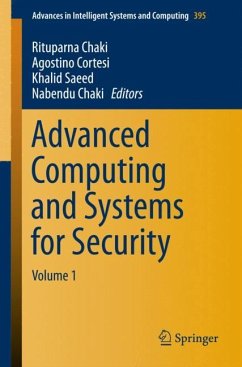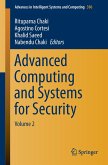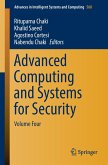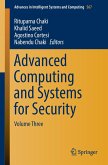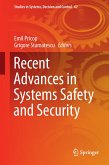Advanced Computing and Systems for Security
Volume 1
Herausgegeben:Chaki, Rituparna; Cortesi, Agostino; Saeed, Khalid; Chaki, Nabendu
Advanced Computing and Systems for Security
Volume 1
Herausgegeben:Chaki, Rituparna; Cortesi, Agostino; Saeed, Khalid; Chaki, Nabendu
- Broschiertes Buch
- Merkliste
- Auf die Merkliste
- Bewerten Bewerten
- Teilen
- Produkt teilen
- Produkterinnerung
- Produkterinnerung
The book contains the extended version of the works that have been presented and discussed in the Second International Doctoral Symposium on Applied Computation and Security Systems (ACSS 2015) held during May 23-25, 2015 in Kolkata, India. The symposium has been jointly organized by the AGH University of Science & Technology, Cracow, Poland; Ca' Foscari University, Venice, Italy and University of Calcutta, India. The book is divided into volumes and presents dissertation works in the areas of Image Processing, Biometrics-based Authentication, Soft Computing, Data Mining, Next Generation…mehr
Andere Kunden interessierten sich auch für
![Advanced Computing and Systems for Security Advanced Computing and Systems for Security]() Advanced Computing and Systems for Security77,99 €
Advanced Computing and Systems for Security77,99 €![Advanced Computing and Systems for Security Advanced Computing and Systems for Security]() Advanced Computing and Systems for Security39,99 €
Advanced Computing and Systems for Security39,99 €![Advanced Computing and Systems for Security Advanced Computing and Systems for Security]() Advanced Computing and Systems for Security39,99 €
Advanced Computing and Systems for Security39,99 €![Recent Advances in Systems Safety and Security Recent Advances in Systems Safety and Security]() Recent Advances in Systems Safety and Security77,99 €
Recent Advances in Systems Safety and Security77,99 €![Group-target Tracking Group-target Tracking]() Wen-dong GengGroup-target Tracking67,99 €
Wen-dong GengGroup-target Tracking67,99 €![Primer on Client-Side Web Security Primer on Client-Side Web Security]() Philippe De RyckPrimer on Client-Side Web Security43,99 €
Philippe De RyckPrimer on Client-Side Web Security43,99 €![Advances in Computer Science and Ubiquitous Computing Advances in Computer Science and Ubiquitous Computing]() Advances in Computer Science and Ubiquitous Computing117,99 €
Advances in Computer Science and Ubiquitous Computing117,99 €-
-
-
The book contains the extended version of the works that have been presented and discussed in the Second International Doctoral Symposium on Applied Computation and Security Systems (ACSS 2015) held during May 23-25, 2015 in Kolkata, India. The symposium has been jointly organized by the AGH University of Science & Technology, Cracow, Poland; Ca' Foscari University, Venice, Italy and University of Calcutta, India. The book is divided into volumes and presents dissertation works in the areas of Image Processing, Biometrics-based Authentication, Soft Computing, Data Mining, Next Generation Networking and Network Security, Remote Healthcare, Communications, Embedded Systems, Software Engineering and Service Engineering.
Produktdetails
- Produktdetails
- Advances in Intelligent Systems and Computing 395
- Verlag: Springer / Springer India / Springer, Berlin
- Artikelnr. des Verlages: 978-81-322-2648-2
- 1st ed. 2016
- Seitenzahl: 288
- Erscheinungstermin: 13. November 2015
- Englisch
- Abmessung: 235mm x 155mm x 16mm
- Gewicht: 441g
- ISBN-13: 9788132226482
- ISBN-10: 8132226488
- Artikelnr.: 43607139
- Herstellerkennzeichnung Die Herstellerinformationen sind derzeit nicht verfügbar.
- Advances in Intelligent Systems and Computing 395
- Verlag: Springer / Springer India / Springer, Berlin
- Artikelnr. des Verlages: 978-81-322-2648-2
- 1st ed. 2016
- Seitenzahl: 288
- Erscheinungstermin: 13. November 2015
- Englisch
- Abmessung: 235mm x 155mm x 16mm
- Gewicht: 441g
- ISBN-13: 9788132226482
- ISBN-10: 8132226488
- Artikelnr.: 43607139
- Herstellerkennzeichnung Die Herstellerinformationen sind derzeit nicht verfügbar.
Rituparna Chaki is an Associate Professor in the A K Choudhury School of Information Technology, University of Calcutta, India since June 2013. She joined academia as faculty member in the West Bengal University of Technology in 2005. Before that she has served under Government of India in maintaining industrial production database. Rituparna has done her PhD from Jadavpur University in 2002. She has been associated in organizing many conferences in India and abroad as Program Chair, OC Chair or as member of Technical Program Committee. She has published more than 60 research papers in reputed journals and peer-reviewed conference proceedings. Her research interest is primarily in Ad-hoc networking and its security. She is a professional member of IEEE and ACM. Agostino Cortesi received his PhD degree in Applied Mathematics and Informatics from University of Padova, Italy, in 1992. After spending a post-doc at Brown University, in the US, he joined the Ca' Foscari University of Venice. In 2002, he was promoted to full professor of Computer Science. In recent past, he served as Dean of the Computer Science programme, as Department Chair, and as Vice-Rector of Ca' Foscari University for quality assessment and institutional affairs. His main research interests concern programming languages theory, software engineering, and static analysis techniques, with particular emphasis on security applications. He h as published over 100 papers in high level international journals and proceedings of international conferences. His h-index is 15 according to Scopus, and 23 according to Google Scholar. Agostino served several times as a member (or chair) of program committees of international conferences (e.g., SAS, VMCAI, CSF, CISIM, ACM SAC) and he is in the editorial boards of the journals such as "Computer Languages, Systems and Structures" and "Journal of Universal Computer Science". Khalid Saeed received the BSc Degree in Electrical and Electronics Engineering from Baghdad University in 1976, the MSc and PhD Degrees from Wroclaw University of Technology, in Poland in 1978 and 1981, respectively. He received his DSc Degree (Habilitation) in Computer Science from Polish Academy of Sciences in Warsaw in 2007. He is a Professor of Computer Science with AGH University of Science and Technology in Poland. He has published more than 200 publications - edited 23 books, Journals and Conference Proceedings, 8 text and reference books. He supervised more than 110 MSc and 12 PhD theses. His areas of interest are Biometrics, Image Analysis and Processing and Computer Information Systems. He gave 39 invited lectures and keynotes in different universities in Europe, China, India, South Korea and Japan. The talks were on Biometric Image Processing and Analysis. He received about 18 academic awards. Khalid Saeed is a member of m ore than 15 editorial boards of international journals and conferences. He is an IEEE Senior Member and has been selected as IEEE Distinguished Speaker for 2011-2016. Khalid Saeed is the Editor-in-Chief of International Journal of Biometrics with Inderscience Publishers. Nabendu Chaki is a Senior Member of IEEE and Professor in the Department Computer Science & Engineering, University of Calcutta, India. Besides editing several volumes in Springer in LNCS and other series, Nabendu has authored three textbooks with reputed publishers like Taylor and Francis (CRC Press), Pearson Education, etc. Dr. Chaki has published more than 120 refereed research papers in Journals and International conferences. His areas of research interests include image processing, distributed systems, and network security. Dr. Chaki has also served as a Research Assistant Professor in the PhD program in Software Engineering in U.S. Naval Postgraduate School, Monterey, CA. He is a visiting faculty member for many Universities including the University of Ca'Foscari, Venice, Italy. Dr. Chaki has contributed in SWEBOK v3 of the IEEE Computer Society as a Knowledge Area Editor for Mathematical Foundations. Besides being in the editorial board of Springer and many international journals, he has also served in the committees of more than 50 international conferences. He is the founding Chapter Chair for ACM Professional Chapter in Kolkata, India since January 2014.
Security: Chapter 1. Computer User Profiling Based on Keystroke Analysis.- Chapter 2. Heart Based Biometrics and Possible Use of Heart Rate Variability in Biometric Recognition Systems.- Chapter 3. Dynamic Ciphering-15 Based on Multiplicative Polynomial Inverses over Galois Field GF(73).- Chapter 4. On Preventing SQL Injection Attacks.- Chapter 5. Secure Data Retrieval Service in Remote Healthcare.- Systems Biology: Chapter 6. Inference of Gene Regulatory Networks with Neural-Cuckoo Hybrid.- Chapter 7. Detection of Diabetic Retinopathy Using the Wavelet Transform and Feed Forward Neural Network.- Chapter 8. Liver Fibrosis Diagnosis Support System Using Machine Learning Methods.- Chapter 9. Light-Weighted DNA Based Cryptographic Mechanism against Chosen Cipher Text Attacks.- Chapter 10. Genetic Algorithm Using Guide Tree in Mutation Operator for Solving Multiple Sequence Alignment.- Chapter 11. A Comparative Analysis of Image Segmentation Techniques Towards Automatic Risk Prediction of Solitary Pulmonary Nodules.- Networking and Cloud Computing: Chapter 12. SAFE-CLOUD: Secure and Usable Authentication FramEwork for CLOUD Environment.- Chapter 13. KPS: A Fermat Point Based Energy Efficient Data Aggregating Routing Protocol for Multi-sink Wireless Sensor Networks.- Chapter 14. The Design of Hierarchical Routing Protocol for
Wireless Sensor Network.- Chapter 15. Network Selection Using AHP for Fast Moving Vehicles in Heterogeneous Networks.- Chapter 16. Context-Aware Graph Based Visualized Clustering Approach (CAVCA).- Chapter 17. Materialized View Construction Using Linearizable Non-Linear Regression.
Wireless Sensor Network.- Chapter 15. Network Selection Using AHP for Fast Moving Vehicles in Heterogeneous Networks.- Chapter 16. Context-Aware Graph Based Visualized Clustering Approach (CAVCA).- Chapter 17. Materialized View Construction Using Linearizable Non-Linear Regression.
Security: Chapter 1. Computer User Profiling Based on Keystroke Analysis.- Chapter 2. Heart Based Biometrics and Possible Use of Heart Rate Variability in Biometric Recognition Systems.- Chapter 3. Dynamic Ciphering-15 Based on Multiplicative Polynomial Inverses over Galois Field GF(73).- Chapter 4. On Preventing SQL Injection Attacks.- Chapter 5. Secure Data Retrieval Service in Remote Healthcare.- Systems Biology: Chapter 6. Inference of Gene Regulatory Networks with Neural-Cuckoo Hybrid.- Chapter 7. Detection of Diabetic Retinopathy Using the Wavelet Transform and Feed Forward Neural Network.- Chapter 8. Liver Fibrosis Diagnosis Support System Using Machine Learning Methods.- Chapter 9. Light-Weighted DNA Based Cryptographic Mechanism against Chosen Cipher Text Attacks.- Chapter 10. Genetic Algorithm Using Guide Tree in Mutation Operator for Solving Multiple Sequence Alignment.- Chapter 11. A Comparative Analysis of Image Segmentation Techniques Towards Automatic Risk Prediction of Solitary Pulmonary Nodules.- Networking and Cloud Computing: Chapter 12. SAFE-CLOUD: Secure and Usable Authentication FramEwork for CLOUD Environment.- Chapter 13. KPS: A Fermat Point Based Energy Efficient Data Aggregating Routing Protocol for Multi-sink Wireless Sensor Networks.- Chapter 14. The Design of Hierarchical Routing Protocol for
Wireless Sensor Network.- Chapter 15. Network Selection Using AHP for Fast Moving Vehicles in Heterogeneous Networks.- Chapter 16. Context-Aware Graph Based Visualized Clustering Approach (CAVCA).- Chapter 17. Materialized View Construction Using Linearizable Non-Linear Regression.
Wireless Sensor Network.- Chapter 15. Network Selection Using AHP for Fast Moving Vehicles in Heterogeneous Networks.- Chapter 16. Context-Aware Graph Based Visualized Clustering Approach (CAVCA).- Chapter 17. Materialized View Construction Using Linearizable Non-Linear Regression.

